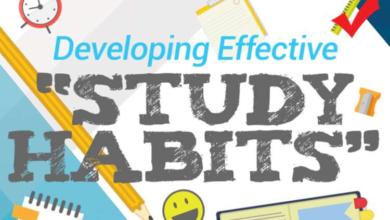Study Habits of Top Students You Should Copy
Study habits of top students should copy to boost academic success. Learn proven strategies for effective learning, time management, and self-care

The study habits of top students are a testament to the power of intentionality and discipline in achieving academic success. While many assume that high achievers are simply born with exceptional intelligence, the truth is that their success is often the result of carefully cultivated routines and strategies. These students don’t just work harder—they work smarter, leveraging proven techniques to maximize their learning efficiency, manage their time effectively, and maintain a healthy balance between academics and personal well-being. By understanding and adopting these habits, anyone can elevate their academic performance and unlock their full potential.
What sets top students apart is their ability to approach learning with a growth mindset and a clear sense of purpose. They prioritize active engagement over passive consumption, set realistic goals, and consistently refine their methods to suit their evolving needs. Whether it’s through strategic time management, optimizing their study environment, or prioritizing self-care, these students understand that success is a holistic endeavor. This article delves into the key habits that define high achievers, offering actionable insights and practical tips to help you incorporate these practices into your own academic journey. By embracing these strategies, you can transform the way you learn and achieve the results you’ve always aspired to.
The Power of Active Learning
Top students prioritize active learning over passive consumption. Instead of rereading textbooks or highlighting notes, they engage with content through techniques like self-quizzing, summarization, and teaching concepts to peers. For instance, a medical student might use flashcards to test their grasp of anatomy, while an engineering student could solve problem sets without referencing formulas. This approach forces the brain to retrieve information, strengthening neural pathways and improving long-term retention. Studies show that active learners retain 50–70% more material compared to passive learners. Additionally, tools like the Feynman Technique—simplifying complex ideas into plain language—help identify gaps in understanding. By transforming study sessions into interactive experiences, top students turn abstract concepts into actionable knowledge.
Strategic Time Management
High achievers treat time as a finite resource, meticulously planning their schedules to balance academics, extracurriculars, and rest. They often use frameworks like the Pomodoro Technique, breaking study sessions into 25-minute intervals with short breaks to sustain focus. Tools like digital calendars or time-blocking apps help them allocate specific windows for tasks, reducing procrastination. Crucially, they prioritize tasks based on urgency and importance, often tackling high-effort assignments during peak productivity hours. For example, a law student might draft essays in the morning when their mind is fresh and reserve evenings for lighter reading. By avoiding multitasking and setting clear boundaries, they minimize distractions and maintain momentum.
Goal Setting and Incremental Progress
Top students set SMART goals—Specific, Measurable, Achievable, Relevant, and Time-bound—to maintain direction. Rather than aiming to “study chemistry,” they might target “mastering redox reactions by Friday.” Breaking large projects into smaller milestones prevents overwhelm and creates a sense of accomplishment. A computer science student, for instance, might divide a coding project into daily objectives: researching algorithms on Monday, drafting pseudocode on Tuesday, and debugging on Wednesday. Regular self-assessment, such as weekly reviews of progress, allows them to adjust strategies and stay on track. This iterative process fosters resilience, as setbacks become opportunities for refinement rather than failures.
Optimizing the Study Environment
Environment plays a pivotal role in cognitive performance. Top students curate distraction-free zones, often favoring quiet libraries or minimalist home setups. They eliminate digital distractions by using apps like Focus@Will or Freedom to block social media during study hours. Lighting and ergonomics are also prioritized; natural light and ergonomic chairs reduce fatigue during long sessions. Some incorporate ambient noise or classical music to enhance concentration, though preferences vary. A philosophy major might thrive in a bustling café, using background chatter to stimulate creativity, while a math prodigy requires absolute silence. The key is consistency—associating a specific space with focused work trains the brain to enter “study mode” effortlessly.
Health as a Foundation for Success
Academic excellence is unsustainable without physical and mental well-being. Top students prioritize sleep, recognizing that 7–9 hours nightly enhances memory consolidation and problem-solving skills. Nutrition is equally critical; brain-boosting foods like walnuts, blueberries, and dark chocolate feature prominently in their diets. Exercise, too, is non-negotiable—a 30-minute walk or yoga session can elevate mood and cognitive clarity. Mindfulness practices, such as meditation or journaling, help manage stress and prevent burnout. A neuroscience student, for example, might pair morning runs with evening meditation to sustain mental stamina during exam periods. By viewing self-care as integral to productivity, they avoid the trap of sacrificing health for short-term gains.
Leveraging Resources and Collaboration
High achievers proactively seek resources beyond textbooks. They attend office hours, form study groups, and use online platforms like Khan Academy or Coursera to supplement learning. Collaboration is key; explaining concepts to peers deepens their own understanding, while diverse perspectives uncover novel solutions. A physics major might join a research lab to apply theoretical knowledge, while a literature student participates in writing workshops. Feedback is embraced as a growth tool—whether from professors, tutors, or AI-driven platforms like Grammarly. This openness to external input accelerates improvement and fosters a growth mindset.
Consistency Over Intensity
The most overlooked habit is consistency. Top students avoid cramming by distributing study sessions over weeks or months, a method known as spaced repetition. This aligns with the brain’s natural forgetting curve, ensuring information transitions from short-term to long-term memory. Even during “off” days, they dedicate 20–30 minutes to review notes, keeping material fresh. A language learner, for instance, might practice vocabulary daily via apps like Anki, gradually building fluency without burnout. Over time, these small, sustained efforts compound into mastery.
Adaptability and Resilience
Finally, top students remain adaptable. They experiment with techniques, discarding what doesn’t work and refining what does. After a poor Students exam result, a biology student might switch from solo study to group discussions, discovering that verbalizing concepts solidifies recall. Resilience is cultivated through reflection; journaling about challenges helps them identify patterns and devise solutions. This flexibility ensures they thrive even under unpredictable academic pressures.
Read More: Time Management Tips for Students to Ace Their Exams
Conclusion
The study habits of top students are rooted in intentionality, discipline, and self-awareness. By embracing active learning, strategic time management, and holistic self-care, they transform education into a sustainable, rewarding journey. These habits are not exclusive to “geniuses”—they are skills anyone can develop with practice. Whether you’re a high school freshman or a doctoral candidate, adopting these strategies can unlock your potential and redefine your academic trajectory.
Success is not about innate brilliance but the willingness to innovate and persist. Start small: integrate one habit, refine it, and gradually build a system tailored to your strengths. Remember, the goal isn’t perfection but progress. As you experiment with these techniques, you’ll discover that academic excellence is less about cramming and more about cultivating a mindset of curiosity, resilience, and balance.
FAQs
How long does it take to form a study habit?
Consistency is key—research suggests 21–66 days. Start with 15-minute daily sessions and gradually increase.
Can I balance studying with social life?
Yes. Time-blocking ensures dedicated slots for both. Prioritize tasks and learn to say “no” to non-essential activities.
Are digital tools effective for productivity?
Apps like Notion or Forest can enhance focus, but avoid over-reliance. Use them to complement, not replace, active learning.
How do I stay motivated during slumps?
Revisit your goals, reward small wins, and seek accountability partners. Embrace flexibility—adjust routines without guilt.
Is sleep really that important for studying?
Absolutely. Sleep aids memory consolidation and cognitive function. Sacrificing rest undermines long-term retention and problem-solving.







